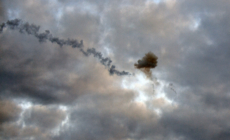-
Yesterday’s Cars Are Shaping Tomorrow’s Software-Defined Vehicles - 9 mins ago
-
At packed town hall, Democratic Sen. Adam Schiff warns of a ‘constitutional crisis’ - 13 mins ago
-
Opinion | How I Describe Myself Politically These Days - 30 mins ago
-
A ‘Drone Wall’ Is Coming to NATO’s Eastern Border - 44 mins ago
-
Suspect in dog abuse video in Long Beach arrested, police say - 54 mins ago
-
How to Watch Pope Francis’ Funeral - about 1 hour ago
-
Illinois Progressive Jan Schakowsky Joining Democratic Exits from Congress: Report - about 1 hour ago
-
Trump’s DOJ targeted L.A. County over gun permits. Who might be next? - 2 hours ago
-
Florida Sues Snapchat Over Childhood Addiction - 2 hours ago
-
Tariffs on China Aren’t Likely to Rescue U.S. Medical Gear Industry - 2 hours ago
UK Aircraft Carrier Begins Pacific Mission in Boost for US
A British aircraft carrier, HMS Prince of Wales, commenced a high-profile deployment on Tuesday, which will see the warship lead a naval strike group to the Western Pacific Ocean.
The eight-month mission, codenamed Operation Highmast, comes as the United States, a major ally of the United Kingdom, seeks to maintain its naval dominance, while China is expanding its military reach and presence with the largest navy in the world by hull count.
Newsweek has reached out to the Chinese Defense Ministry for comment by email.
Why It Matters
This is the second Pacific deployment of a Royal Navy carrier strike group since 2021, when the Prince of Wales‘ sister ship, HMS Queen Elizabeth, was tasked with a similar mission.
Operation Highmast also marks the second deployment of a European aircraft carrier in the region in less than a year. France, another key member of the U.S.-led NATO alliance, dispatched its only aircraft carrier, FS Charles de Gaulle, for a five-month Indo-Pacific mission last November.
Meanwhile, the U.S. Navy has deployed two of its 11 aircraft carriers, USS Nimitz and USS George Washington, in the Western Pacific. Their sister ships, USS Carl Vinson and USS Harry S. Truman, are stationed in the Middle East to conduct airstrikes in Yemen.

BEN STANSALL/AFP via Getty Images
What To Know
Following what the Royal Navy called “extensive training,” the Prince of Wales, which is the U.K.’s flagship and has 1,600 military personnel on board, left Portsmouth Naval Base in southern England with the destroyer HMS Dauntless, which is part of the carrier strike group.
The Prince of Wales and the Dauntless will be joined by five other naval vessels, according to the Royal Navy, incorporating a pair of British ships, the frigate HMS Richmond and the tanker RFA Tidespring, as well as two Royal Norwegian Navy ships and a Canadian frigate.
“[Operation Highmast] will reaffirm that the U.K. is secure at home and strong abroad and reinforce the U.K.’s commitment to the Indo-Pacific,” said Royal Navy Commodore James Blackmore, who is the commanding officer of the Prince of Wales-led carrier strike group.
The British-led naval task group—with its up to two dozen F-35B stealth fighter jets—is scheduled to conduct a number of exercises and operations with allies in the Mediterranean, Middle East, Southeast Asia, Japan, and Australia until December.
London will signal its intention of maintaining a presence in the Indo-Pacific region through this deployment, said Nick Childs, senior fellow at the International Institute for Strategic Studies, adding that the security environment is more uncertain than it was four years ago during the previous Royal Navy carrier strike group Pacific deployment.
“While the U.K. government propounds a ‘NATO first’ strategy, it also asserts that Euro-Atlantic and Indo-Pacific security are indivisible,” Childs explained, noting that Operation Highmast aims to uphold “principles against which China is widely seen as the main challenger.”
What People Are Saying
U.K. Defense Secretary John Healey said: “As one of only a few nations capable of leading a deployment of this scale, the Royal Navy is once again demonstrating that U.K. defense is strong, modern, and ready to meet the threats of today and tomorrow.”
Nick Childs, senior fellow at the International Institute for Strategic Studies, said: “Global events may yet force changes of plan, but one way or another, the lessons learned from this deployment, and its perceived strategic impact, will significantly shape the future of U.K. defense.”
What Happens Next
It remains to be seen whether the Prince of Wales will take part in the U.S. aerial bombing campaign targeting Iranian-backed Houthi rebels in Yemen when it reaches the Red Sea.
Source link


















